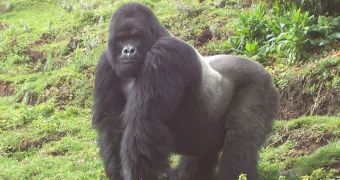Gorillas split from the branch that evolved towards humans and chimps about 10 million years ago, thus gorillas are equally related to us as to chimps.
Gorillas have been split in two species. Western gorillas (Gorilla gorilla) have silverback males (the male leader of a gorilla family has the back whitish) with a very large white back stripe and nostrils diffusely delimited.
The eastern gorilla (Gorilla beringei) has two forms. The lowland eastern gorilla (G b graueri) has a smaller white stripe, the nostrils well delimited, and jaws with extremely large teeth. The mountain gorilla (G b beringei) has longer, thicker hair, small nose, large jaws and teeth, and a rounded nose's bourrelet.
The mountain gorillas live in the Virunga volcanic mountains of Central Africa, inside 3 national parks: Mgahinga (south-west Uganda), Volcanoes (north-west Rwanda) and Virunga (the Eastern Democratic Republic of Congo); and also in Uganda's Bwindi Impenetrable Forest. The Virunga population consists in about 380 individuals, the Bwindi gorillas number about 300, and the mountain gorillas are amongst the most menaced primates. The mountain gorillas live in cloudy, cold forests ranging from 2225 to 4267 m (7300-14000 ft), including African redwood (Hagenia) and abounding in mosses, ferns and orchids.
When the male gorilla reaches adulthood (14 years), his back turns into white and he seeks forming a clan or eliminating a silverback from another clan. If the male succeeds in eliminating a silverback, he will kill all the young ones from the group, in order to make females enter the heat and give birth to his own offspring. Only a silverback mates with the females; if a young male tries to mate with a female, the silverback expels it rapidly from the group. Silverbacks display themselves by chest beating accompanied by horrific shouts.
A mountain gorilla silverback reaches up to 1.8 m (5-6 ft) in height, it has an arm span of 2.25 m (7 ft 6 in) and weighs up to 227 kg (500 pounds). A silverback eats up to 30 kg (67 pounds) per day. Females are much smaller; they never live isolated, but in a group (family).
The mating of the gorillas is slow, cumbersome, and ...discrete. A female gives birth to a young one once at 3.5-4.5 years. Gorillas live up to 40 years.
Like all apes, gorillas make nests, but on the soil. They urinate and defecate in the nest!
Gorillas have a territory of 5-10 square km (2-4 square m) in the rich areas and 25-40 square km (10-16 square m) in areas poor in food. Mountain gorillas are vegetarian and their preferred food is leaves, shoots and stems of giant groundsels (Senecio), wild celery, bamboo shoots, thistle, nettles, bedstraws, many roots and vines. They are not smarted by nettles because of the thick hand skin.

 14 DAY TRIAL //
14 DAY TRIAL //